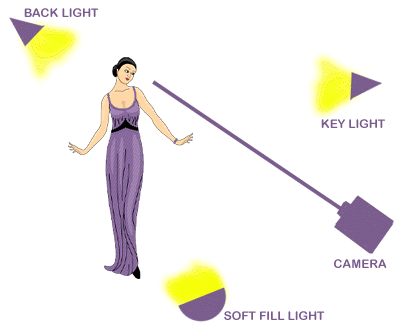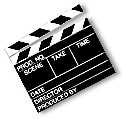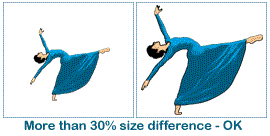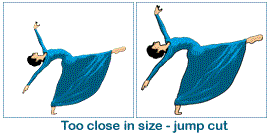
 Jump cuts. Those irritating scene changes that make you squinch inside. It used to be that putting a jump cut transition into a video production was the mark of a non-professional. Read the rule books and they tell you that you can't change from one shot to another unless the change in the size of the subject is more than thirty percent, or the change in the angle from which you observe the scene is more than thirty degrees.
Today we tend to be a bit more independent about such rules. Rather than trying to avoid making you squinch, a fast-paced MTV-type video might well intend to make use of that exact squinchy feeling. So why name this column Jump Cut? No, it's not because I'm hoping to leave you with a feeling of ants crawling up your back. It's because I intend to jump around a number of different video production subjects, and because I hope that what you'll get out of these columns is some history, some rules, and some encouragement to experiment with those rules. Video production isn't a completely different animal than film production. It's more like a poor first cousin. Some of the differences come from the fact that a piece of film is handled differently than a piece of video tape. Some of the similarities come from the fact that you're trying to achieve the same effect. Movies are typically shot with one camera. When you have five people sitting around a table talking, you'll actually move the camera so that you focus on each person as they're doing their lines. You aren't shooting the scene in real time. You're shooting the scene over and over and over again from various angles. If you're focusing in on the hero, for example, the other people might not even be there. The actor may well be hearing a young girl reading the lines of an angry man. What makes him a great actor is that he reacts to her lines with the same intensity and control that he would if his nemesis were really there. The lighting for this scene might have to be modified when the camera is in its various positions. This type of careful, dramatic lighting is often called the "film look". When video first started being used on television, it was often used on productions like soap operas that wanted to keep costs really low. To save time (which is money) on lighting, for example, the whole set might be lighted in a bright, flat way that was never ideal, but always adequate, for shooting different people from different angles. TV wasn't the only place that made use of this type of lighting. If you were shooting in an office for an industrial video, for example, you could take a very large light and point it at the low white ceiling. The reflected light brightly fills the room so that everything is clearly seen, if not dramatically shown. For a long time, people thought of that flat, bright look as the "video look". But it never was intrinsic to the use of video. Though we don't have as wide a range of darks and lights in video as filmmakers have in film, we still have enough to make scenes that are dramatically lit -- to, as the experts say, paint our scenes with shadows. So what is the classical film way of lighting a scene? A typical lighting setup for a single person uses three lights -- a key light that generally lights the subject and the scene, a back light that separates the person from the background to emphasize the three-dimensionality of the scene, and a fill light that eliminates the shadows cast by the key light.
 Unlike bungee jumping, lighting a subject with three lights is something you can do at home. Don't have a Lowell lighting kit around the house? No problem. There's always those great reflectors you can buy cheap at the local hardware store. Just pop in a good bright bulb and look around for safe places to clamp them. Reflectors and lights get very hot. Professionals clamp lights onto poles for ease of use and for safety. You might find the top of a tall ladder is a good substitute. Taking advantage of the jumping in this column title for a somewhat related aside, I am reminded of a salesman at the National Association of Broadcasters (NAB) exclaiming over newly available leather gloves. One of their claims to fame, he explained, was that unlike the previous gloves they had sold, THESE gloves did not catch on fire while adjusting lighting instruments. Now what else do professionals have in their bag of tricks? Actually quite a ragtag assortment. Not everything comes from expensive lighting stores. One lighting director scavanges for odds and ends on the floors of conventions that are being broken down. Velvet scraps to use as backdrops for closeups of objects. Tinfoil to shape into flags to interrupt light and reduce glaring reflections. Masking tape crisscrossing over frames to act as a gobo to cast interesting shadows on a plain and boring wall. (Lighting directors have the most marvelous names for their gizmos.) Why would you want to learn about lighting a subject? Even if you don't want to take on the responsibility of a weekly cable show of your own, you might want to develop your skills for video that you shoot of your family and your friends. Sure, you could read books on lighting techniques, but wouldn't it be more fun to learn from a real live person who could answer questions while you work? Next time you're at a movie, sit through the credits. The Director of Photography (DP) is responsible for the lighting and look of the film. The gaffer is essentially the first assistant to the DP. Before a scene is shot, the DP might walk through the area and plan out the lighting. The gaffer would take the DP's plan and make sure that there was enough power to handle all the lights, that the lights were up in approximately the right places, etc. Then the DP comes in to make the subtle corrections that turns adequate into art. The actual electrical grunt work might be handled by the best boy (who could be a 50 year old female). One suggestion is that the title "best boy" comes from early sailing ships, since sailors were often hired to set up and work the riggings of theaters. Now, while we can't guarantee you that working in a cable studio will get you a shot at a job in Hollywood, we can say with some certainty that you will find yourself to be a more informed reader of movie credits. And one heck of an interesting dinner guest.
INTERESTING EXAMPLES
RECOMMENDED READING
WISH LIST

|





